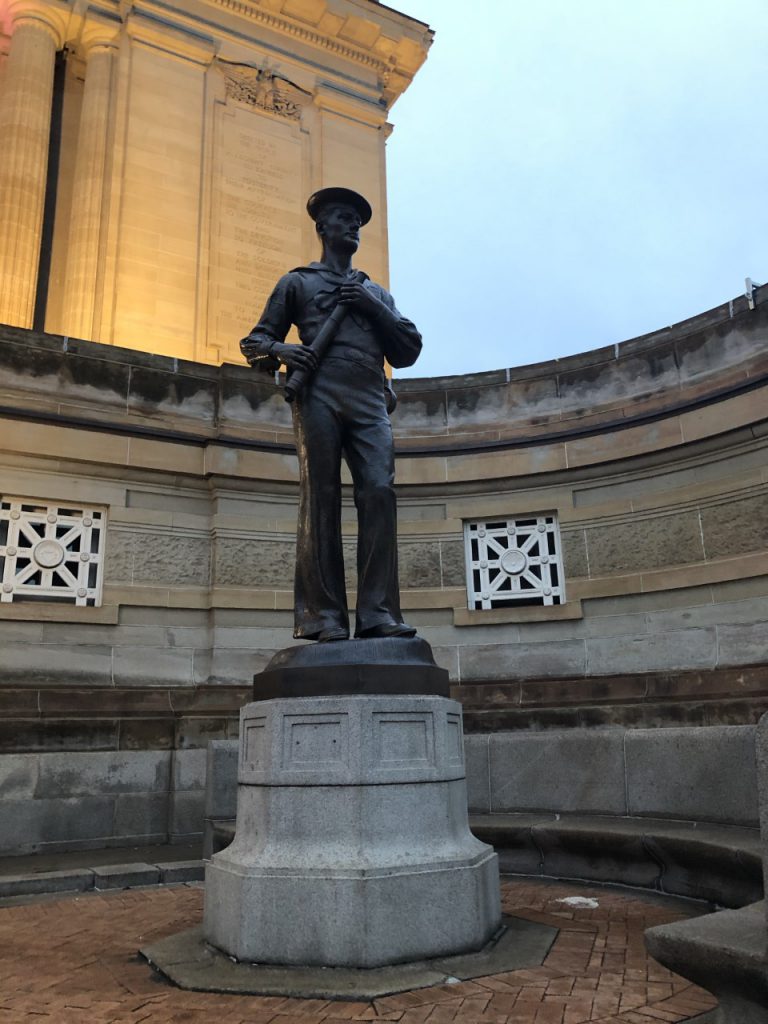By David Hall
September 2021

Photo by author. “Statue of soldier on the left of doors.” 
Photo by author. “Statue of sailor on the right of doors.”
In the center of Oakland stands Soldiers and Sailors Memorial Hall and Museum, a building much like a classical temple. But instead of a place of worship, it is a place to honor American veterans and those who lost their lives fighting for their nation. This memorial is steeped in American symbols that have taken on a sacred nature—a phenomenon that is called American Civil Religion. Coined by Robert Bellah, a sociologist of religion, American Civil Religion is not a religious identity but a way to think about how Americans interact with and view national symbols and ideas. In this religion, Soldiers and Sailors becomes a temple for martyrs.
The Grand Army of the Republic opened Soldiers and Sailors in 1910 as a memorial to veterans of the Civil War. Over the years, Soldiers and Sailors expanded to honor veterans in more recent conflicts like Iraq and Afghanistan. Soldiers and Sailors was designed by Henry Hornbostel shortly after he designed a nearby synagogue, Rodef Shalom. Like a house of worship, the parallels between these sacred spaces are clear.

Sacred symbols are on proud display at Soldiers and Sailors, from the eagles overlooking the plaza, to the American flag hoisted high above Fifth Avenue. Each of them carries a deep emotional response that evokes patriotism. Around the entrance and perimeter sit solemn memorials of American wars and conflicts. These memorial plaques, like those found in memorial parks or graveyards, call back to ideas of martyrdom and remembrance of the dead.
Symbols, such as the American flag and bald eagle, are aspects of American Civil Religion in how they inspire piety through patriotism. Across the United States, American symbols are treated on par with sacred symbols and objects like the Bible or a cross. Similarly, Americans give texts like the Declaration of Independence and Constitution a great deal of reverence, like that of a holy text. Speeches like Lincoln’s Gettysburg Address are sermon-like and call upon a vaguely monotheistic or Abrahamic God who watches over America.
Along the walls, relics of wars are carefully kept and presented to transform the space into a place of remembrance. On the front wall of the auditorium, the Gettysburg Address is printed on full display and visible from the entire room. It sits above a row of bald eagles and is framed by pillars on either side. This positioning, along with the artifacts found in the rest of the museum, transform the interior space into something more than a museum. In many ways, you can describe it as a temple to America’s memory. The prominence and display of many “American” symbols Soldiers and Sailors is indicative of the many ways American Civil Religion is embedded in Pittsburgh’s religious landscape.
Featured Image
Photo by author. “Front view of Soldiers and Sailors Memorial Hall and Museum.”
Further Reading
Bellah, Robert. “Civil Religion in America.” Journal of the American Academy of Arts and Sciences, 2005. web.archive.org/web/20050306124338/http://www.robertbellah.com/articles_5.htm
Soldiers & Sailors Memorial Hall and Museum. Soldiers & Sailors Memorial Hall and Museum, 2018. www.soldiersandsailorshall.org
Gardella, Peter. American Civil Religion: What Americans Hold Sacred. Oxford University Press, 2014.
How to Cite
MLA: Hall, David. “Soldiers and Sailors Memorial Hall and Museum.” ReligYinz: Mapping Religious Pittsburgh, University of Pittsburgh, 22 Sept. 2021, religyinz.pitt.edu/soldiers-and-sailors/
APA: Hall, D. (2021, September). Soldiers and sailors memorial hall and museum. ReligYinz: Mapping Religious Pittsburgh, University of Pittsburgh. https://religyinz.pitt.edu/soldiers-and-sailors/
Chicago: Hall, David. “ Soldiers and Sailors Memorial Hall and Museum.” ReligYinz: Mapping Religious Pittsburgh. University of Pittsburgh, September 22, 2021. https://religyinz.pitt.edu/soldiers-and-sailors/
